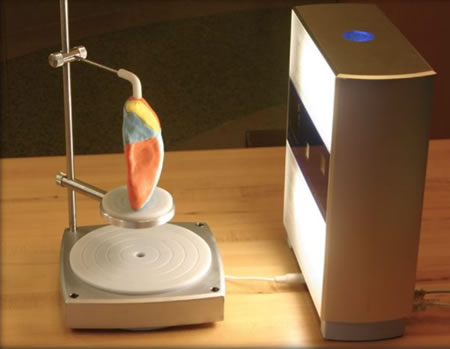As I dabble into mold making I find myself looking into other areas. We are certainly not at a stage of technology, to clone everything to get a spare copy of something. If we was, I would of borrowed a Mac book pro and returned it the same day. Knowing I have a unlimited supply of disposable laptops, I would have less sentiment for the machine.
Instead we are at a point where we can replicate solid forms and produce complex forms with or without the use of mold technology. I must admit I find the wonderful world of 3D printing a fascinating and exciting subject.
The idea of 3D printers have been around about 30 years, a industrial commercial printer would typically cost more then £16,000. The Rep-Rap Project created by Adrian Bowyer of Bath University, was an initiative that started in the summer of 2005. Rep-Rap short for replicating rapid prototyper fuses molten plastic to a fixed base. In the same principle of a 2D laster printer, a Rep-Rap machine would draw the cross section and add layer upon layer until all 3 dimensions are complete. To date the rep rap project has released 3d printing machines Darwin in March 2007, Prusa Mendal, in October 2009 and Huxley in 2010.
As an open source project it was to share designs and free to make copies, it was to hoped that each machine would make plastic parts of the 3D printer itself which would self replicate most of the parts need for a complete copy.
The use of 3D designs would allow the use of virtual drawing forms Computer Aided designs (C.A.D.) or animation modeling software to be constructed by printer. This would allow complex designs and intricate work or even miniaturization of image file. there are two possibilities of having a design ready for printing.
The first is to draw your design with the use of CAD software which might be too complex for the average consumer. The second is to use a 3D scanner, this uses a laser and camera configuration which triangulates the object and builds up a picture through special software.
Most 3D scanner products use a this method along with sophisticated software to filter out unwanted noise and object. Though not widely used by the general public, it has been used for scanning objects into the virtual world for second life. A good fast way of making money by selling objects of desire in a virtual world for those people who built them selves a home.
Despite scanners costing thousands of pounds there are ways around by using a web cam and demo software which would work in the same way. lasers can be brought cheaply from Ebay and webcams and software can be obtain online too. Though more effort is needed to clean up the image, A STL file (Standard Tessellation Language file) can still be obtained for a Printer to make. A STL file describes a raw unstructured triangulated surface, it specifies both ASCII and Binary representations. There is also a Kinect hack where by a camera end of a kinect device connected to a computer, can scan and collect 3D data in real time.
The consumer electronics show in 2012 showcased a new product from Cubify, which is a user friendly 3D printer along with a kinect device to scan 3D images of people. The printer has a cartridge that can be easily changed and a overall design much more pleasing to the eye the a Rep-Rap machine.
It would seem the next step is to have a user friendly machine, Cubifys web site has a design section for people to upload their own design and sell their product Visitors have the option to buy pre-made items or the print files to use on their own machines they have brought from the website. Consumables are available for the printer itself and comes in many colors. The designs included are from simple Iphone coves, to shoes, to flexible material used for gloves and clothes. the possibilities are endless, though it is still early from CES. It looks like a possible that 3D printing will be a popular as this user friendly device hits the markets. The printer has a limited build dimensions of 5 by 5 by 5 inches a single cartridge is $50 and a printer is $1.299.
It's not cheap to buy but if success carries on it might come down in price, considering early models have cost thousands of pounds.
Personally I would like to like to see if prices will fall, or if the company will develop a 3D scanning technology that will go hand in hand with the printer. It is still too early but with features like a design library to pick and choose items to print. This community based idea to sell 3D designs similar to the app store from Apple, will help push open the doors for designers and for the printers itself. Printing times might take a while to manufacture depending on print size, though it might improve in the future. I am hoping future machines will allow a mix of colors, or that flexible material can be used instead of plastics.





No comments:
Post a Comment